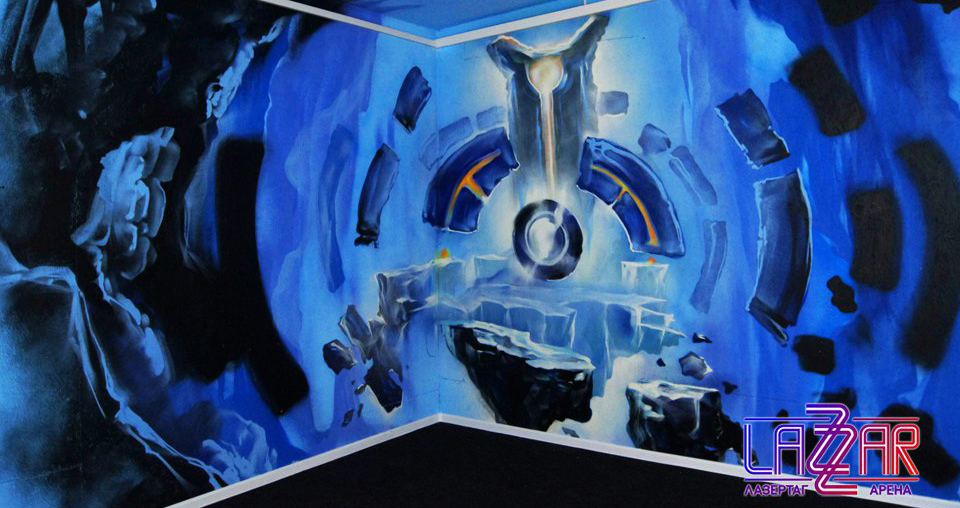Good lighting is everything

We can get really creative as we build shape, direct light onto details that need to be illuminated, hide secret corners, attribute game functions to the interior accessories.
This article is devoted to the maze – the place where the game itself takes place. We are not going to mention the waiting room or the room for instructions, as their design is only an addition to the labyrinth, not the other way around.
Our maze comprises a set of elements that need to be worked upon. Any labyrinth is made up of a floor, walls, a ceiling, technic elements. We will take a closer look at them one by one.
Interactive LED-floors
There is no doubt about it that introduction of interactive illuminated floors is among the most expensive ways to design a labyrinth. They may become an attribute no game will do without.
Modern LED-floors greatly vary in shapes and sizes, for this reason they may be used to design absolutely different places. Modular construction allows for easy mounting and dismounting of the floor surface, repair and replacement. Protective layer made of crack and slip resistant coating is made to withstand prolonged and intense use. Besides, DMX-signals help achieve player-interiors interaction. For instance, players may leave foot marks as they move on the floor, which will let other players know their enemy’s direction. There is an option to light up the part of the floor on which a player is standing. The colour of the light will let other participants know whether there is anyone on their territory. This feature can be used to achieve the opposite effect, to misguide everyone, by placing a heavy object on the floor.
Walls will benefit from paint that does not wear out
Walls require special attention, since they are always a focal point. Fortunately, they can be designed in a variety of ways, starting from fluorescent wallpaper to stencil patterns performed by glowing paints. This all will help to personalize design in your labyrinth.
Fluorescent 3D-wallpaper (cyber-paper) is a unique component that helps create an extraordinary atmosphere inside buildings.
In the common daylight such wallpaper is colourful pictures with high quality images, but when the back-light (ultraviolet) is on one sees a 3D picture, which creates the illusion of reality. Fluorescent 3D-wallpaper is extremely attractive.
Besides the wallpaper, artists are getting more keen on fluorescent design, while fluorescent paints keep gaining popularity among lovers of unusual things. It still remains unclear to many what “glowing paint” is and how it works.
Influenced by ultraviolet waves, fluorescent paint glows in the dark and makes any image look like firework in the night. But it is quite bright even in daytime, for as light meets the surface of the image painted by fluorescent paint, the light ray doesn’t get absorbed by the surface as usual, but its brightness increases due to light energy being transformed.
All fluorescent paints glow when ultraviolet light is on. The wide range of pigments makes creating stunning effects possible.
You cannot jump above your head
Ceilings design fully depends on your budget. Many don’t consider this part of the labyrinth really important, so they omit it altogether. It’s important to mention, though, that both the floor and the ceiling create the right atmosphere. If no proper attention is given to the ceiling design, it will give the impression of pressing down on you, while the room will feel small, stuffy and uncomfortable. Thoughtful maze ceiling design is as important an element of the labyrinth as is wall design. Spotlights, laser projectors may be used as well as paints, which can be used to create stunning images just above one’s head.
Technical bits
Speaking about cables, sensors and fasteners, luminous paint is top choice. After it has absorbed and accumulated light energy, this paint later gives it off in the dark without the need for additional light sources use. Both sun rays and rays from artificial light sources including ultraviolet lamps, may all become sources of energy accumulation. The brighter the rays and the longer the process of energy accumulation, the longer the paint will glow in the dark. During the day luminous paint is white in colour, in other words, half-transparent. Even though many manufacturers guarantee up to 10 hours after-glow, it will be wiser to use it to do elements that may change their significance after a while.
They bring everything to life
Lots of luminous paints are used for designing a maze, which means that they have to be livened up. To achieve this, ultraviolet lamps are used throughout. They came to our country’s market not so long ago, but almost immediately gained exceptional popularity thanks to the marvelous light effect they create.
Backlight-lamp manufacturing technology is similar to that of common fluorescent lamps. The only difference is that instead of white glass tube very dark glass is used. This almost black glass is called Wood’s light, and it almost desn’t pass any light through.
An important point to note is that such lamps are safe and the light they project is perfectly safe for a person. The range of ultraviolet lamps production is wide and varied, so it is an easy task for anyone to choose the right product for their needs. First of all, the difference is based on the emitted power, which ranges from 4-9 W to 400-500 W or more. Besides, they vary in shape, size, and configuring.
A step away from success
To conclude the article, we would like to add that designing maze means solving certain tasks. That’s why as you plan your budget you have to understand what your goals are and how you are going to achieve them. Such an approach will help you make the process of labyrinth designing ideal and reduce your spending.